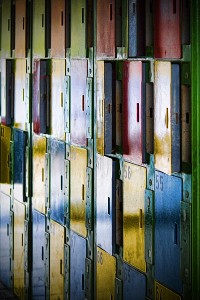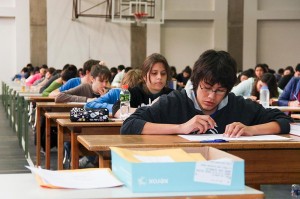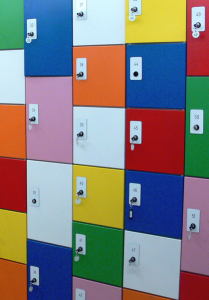
If you are raising a child with ADD, you are undoubtedly used to the copious amounts of clutter that line the walls and furniture of your home. A big problem parents struggle with is that this haphazard attitude extends beyond the home- in fact, most ADD children struggle in school since they lack the ability to organize their space, school books and homework.
The best way to help your child organize his own school environment is by helping him or her set up a system that suits his needs. For example, his school desk should be clean and completely void of clutter and distractions. Attach a small basket on the underside for paper scraps and food wrappers, and designate a specific spot for pencils, pens and highlighter markers so they can be easily accessed during class.
Next, children with ADD may need help organizing their school lockers. Start by adding hooks, shelves, dividers, a mirror or any other feature that will help the child manage their school supplies with minimal stress. A child is better able to avoid distractions when he feels confident that he will be able to find his school supplies and homework without hassle, and a routine will help him or her stay focused on school-related tasks.

Not only are teachers expected to plan interesting and informative classes, but they must be highly organized and help their students be organized. The way classroom furniture, including classroom tables and classroom desks, are organized, can make a huge difference in the amount students learn, and in the way they feel in class.
One expert teacher organized her classroom into several useful sections: a student supply station; her desk, which was at the back of the classroom and where she kept her files, a microwave, and other equipment; a board at the back of the room for special assignments; a whiteboard, agenda board and a document camera, all at the front of the room; and a homework/absent work station. All these classroom elements helped her students know exactly what was expected of them and where they could get what they needed for class, and where to put homework and other assignments. This clarity
of space allowed for clarity of mind.
This expert also has a highly organized way of dealing with all the papers she collects from her students; keeping track of absents and make-up work; organizing school lessons and materials; and documentation of parent communications.
There is certainly a lot a teacher needs to stay on top of, and being organized helps everything flow more smoothly, not just for the teacher, but for the students as well.

When children initially make the transition from a preschool to an elementary school, there are many new concepts with which they have to become familiar. The first is the fact that they will probably have to find a way to transport their books and supplies to and from school. Many schools offer lockers for this. But even that is a new concept for the student and hopefully – at least at the beginning of the academic year – staff members are on hand to help teach the children how to become comfortable with these.
Second, since computers are very often used as an educational tool is schools these days, a new elementary school student will need to become familiar with how to use these. This means that they will have to get comfortable at a computer table and learn how to navigate a mouse.
Third, children will need to get used to dealing with crowds. Preschools in general are small, and elementary schools tend to be larger. One way parents can help ease this transition is by keeping the channels of communication open and ensuring that their child feels comfortable discussing any issues they are having with the transition.
In fact, that is the general rule for parents facilitating the process of change for their children. Ensure that your child feels comfortable discussing any new issues that arise at all times.
Learn some great teaching and organizing tips with Sparkle Teaching Magic:

Most school lockers are made out of steel. However, there are varying levels of quality of steel around. This makes a difference vis-à-vis their duration and how they are used. If students feel that the lockers are hard to open and close, then this is likely to add an extra element of stress to their day. Similarly, if lockers are placed in a location that is hard to access – such as by a stack of folding chairs or near a stairwell – then this can also increase stress levels as well as escalate inefficiency during the school day.
In terms of quality steel, if the gauge is low then the steel will likely be strong. As well, the steel used on the door is usually stronger than the actual locker since doors are used much more than the body of the locker.
So in terms of school lockers and their accessibility and ease-of-use for students, consider first the quality of the steel (and how it is processed/finished) and also carefully think about where the lockers are placed and if they can be put in a location that is free of any type of clutter.
TeacherVision offers ten quick guidelines for teachers for the beginning of a new school year, as well as the important messages they convey to new students:
1. Be prepared. This conveys that you are in control, and that you know what you are doing.
2. Motivate kids. School is exciting!
3. Establish routines and schedules. School is safe and predictable.
4. Establish classroom rules. I will learn self control.
5. Orient students to school/room. I am comfortable and belong here.
6. Preview the curriculum. I will learn new things.
7. Let students decide and choose. We are all in this together.
8. Include a literacy experience. Reading is wonderful!
9. Acknowledge every student. I am special!
10. Review and assign easy work. I can succeed!

The school year has started and you already find that your locker is a mess. You can continue to ignore it and keep stuffing everything into the back, or you can get organized. Getting yourself
organized actually doesn’t take as much time or energy as you might think. Here are some easy ways to get on track and to keep your locker organized.
First, take everything out of your locker and take a look at what you have in there. Throw away papers that you don’t need, junk that has collected and other items. You might want to drag a few classroom
chairs over to your locker so that you can stack up items you want on one chair, trash on another chair and more. Get a sponge or some wet paper towels and actually clean out the bottom or your locker so that you’re starting from a fresh start.
Now, it’s time to put everything back in. Once you’ve throw away things you don’t want, start by organizing your books on the bottom of the locker. Order the books by size, by your schedule or by some other system. If you have room to put in a top shelf, use this space for plastic folders, loose sheets of paper, a purse or gym bag, etc. Get a container or two either from your house or from a store to hold pens, pencils, tape, scissors, a stapler and other loose items.
Finally, if you have magnetic walls, buy a magnetic white board so that you can write messages and reminders to yourself. And buy a magnetic organizer to throw loose change, pencils, paper clips and other items into. And Voila! You’re done. Next you can help a friend clean up her locker, clean up the cafeteria tables and more.





